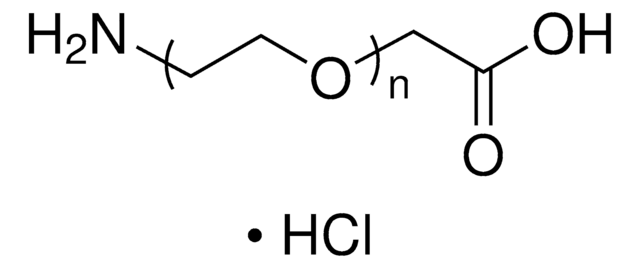QBD10244
Amino-dPEG®4-acid
>95% (HPLC)
Sinónimos:
Amino-PEG-acid, Amino-PEG4-acid, CA(PEG)4, Carboxy-PEG4-amine, NH2-PEG4-COOH
About This Item
Productos recomendados
Ensayo
>95% (HPLC)
Formulario
solid or viscous liquid
idoneidad de la reacción
reaction type: Pegylations
arquitectura del polímero
shape: linear
functionality: heterobifunctional
Condiciones de envío
ambient
temp. de almacenamiento
−20°C
cadena SMILES
NCCOCCOCCOCCOCCC(=O)O
InChI
1S/C11H23NO6/c12-2-4-16-6-8-18-10-9-17-7-5-15-3-1-11(13)14/h1-10,12H2,(H,13,14)
Clave InChI
DKUZHSDZSMQOGQ-UHFFFAOYSA-N
Características y beneficios
Información legal
Código de clase de almacenamiento
11 - Combustible Solids
Clase de riesgo para el agua (WGK)
WGK 3
Punto de inflamabilidad (°F)
Not applicable
Punto de inflamabilidad (°C)
Not applicable
Elija entre una de las versiones más recientes:
Certificados de análisis (COA)
It looks like we've run into a problem, but you can still download Certificates of Analysis from our Documentos section.
Si necesita más asistencia, póngase en contacto con Atención al cliente
¿Ya tiene este producto?
Encuentre la documentación para los productos que ha comprado recientemente en la Biblioteca de documentos.
Global Trade Item Number
| Número de referencia del producto (SKU) | GTIN |
|---|---|
| QBD10244-100MG | 4061842703173 |
Nuestro equipo de científicos tiene experiencia en todas las áreas de investigación: Ciencias de la vida, Ciencia de los materiales, Síntesis química, Cromatografía, Analítica y muchas otras.
Póngase en contacto con el Servicio técnico








